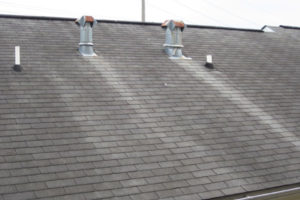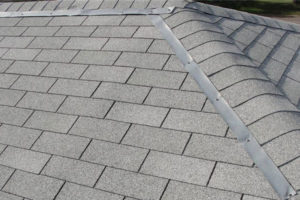Many homeowners have homes with asphalt shingle roof coverings with streaks- i.e., lighter here, darker there.

Take a peek at the photo and guess which areas are stained – lighter or darker?
We hope it’s obvious but if it’s not, the darker areas are actually stained brown or black from algae. Don’t worry if you got the wrong answer, lighter areas often are misdiagnosed as stains when, in fact, the opposite is true!
Lighter areas generally are “clean,” primarily because metal flashing (e.g., zinc and copper) acts as a biocide, limiting algae growth as rainwater runs over the flashing and down the roof.
What is Gloeocapsa Magma?

Algae are everywhere in our natural environment. Algae feed on limestone filler contained in asphalt roof shingles. If you live in a humid area of the country, you’ve probably seen unsightly dark streaks on asphalt shingle roofs. Though often attributed to an accumulation of dirt, defective shingles, mold, or mildew, the most common culprit is actually a blue-green algae known as Gloeocapsa Magma that is spread by airborne spores.
For the many homeowners who want to return the roof to its original color, there are two methods for dealing with a stained roof.
Removal – Make Algae A Thing Of The Past
There are two methods for removing algae stains: chemicals and metal strips.
- Chemicals – The first method for removing algae is to apply homemade or store-bought chemical solutions.
- Good – Relatively quick removal.
- Bad – Algae eventually returns.
- You – You’ll like this approach if you’re looking for a quick-fix or want instant results.

Why don’t new home builders use metal strips all the time?
- Metal Strips – The second method for removing algae involves installation of metal strips to the ridges of the roof. Rainwater over the strips carries metal ions down the roof slope; the ions act as a biocide and remove algae over time.
- Good – Solution is more permanent.
- Bad – It takes longer to remove the algae and, unless you would like to climb on the roof, you’ll probably have to engage a contractor to install the metal strips.
- You – You’ll like this approach if you’re a planner or long-term investor.
Whichever method suits your fancy, there’s one method you most definitely should not use – pressure washer.
Pressure washing can severely and prematurely deteriorate shingle surfaces by removing granules. Also, check the fine print – pressure washing also could void your manufacturer’s warranty.
Prevention –Algae Be Gone
Of course, preventing algae growth is easier if the process starts during construction or re-roofing because a more thorough installation of metal strips can be applied to ensure metal ions coat the roof during every rainfall. Roof ridge vents are constructed to include metal inserts for the purpose of algae prevention.
- Metal Strips – Metal strips sound like they would look terrible, but they’re not bad at all. As the metal weathers, the color blends into most shingle colors over time. Adding metal strips can be an effective course of prevention for up to 10 years.
- Algae-resistant shingles – Such shingles cost slightly more per square, but the cost is offset by avoidance of regular cleanings or metal strip installation.
- Sol vs. Sombra (Sun vs. Shade) – Shady areas of roofing or areas that face north are more prone to algae growth. Therefore, trimming nearby trees will ensure that more sunlight reaches the roof, slowing down future growth.
